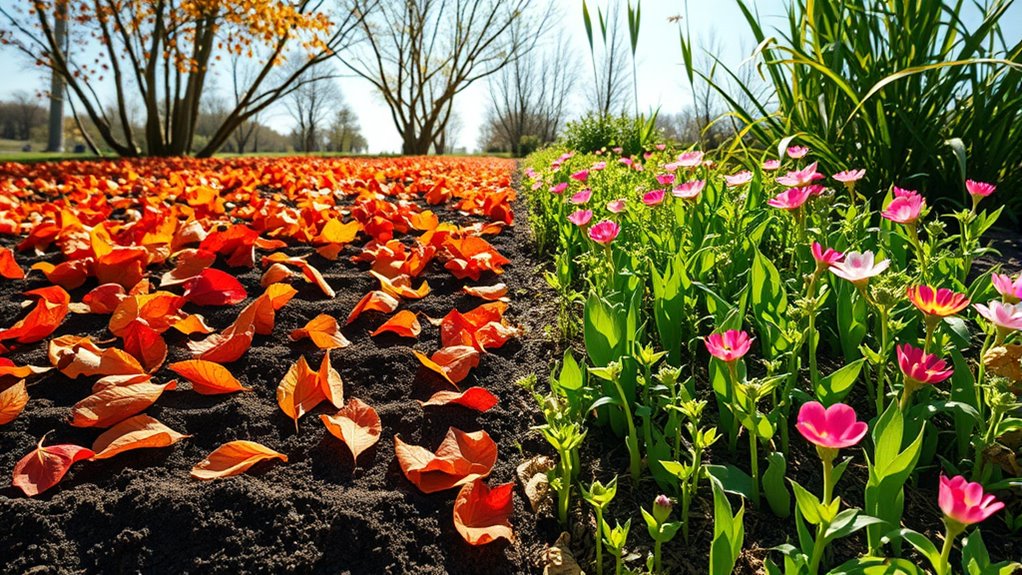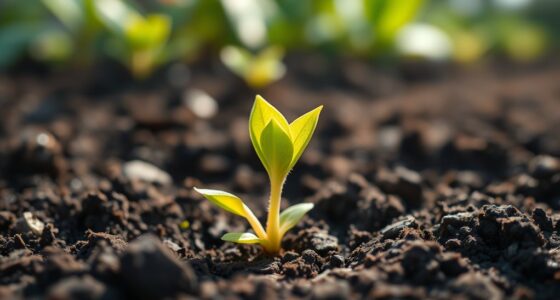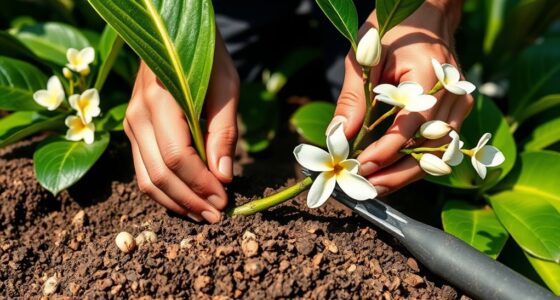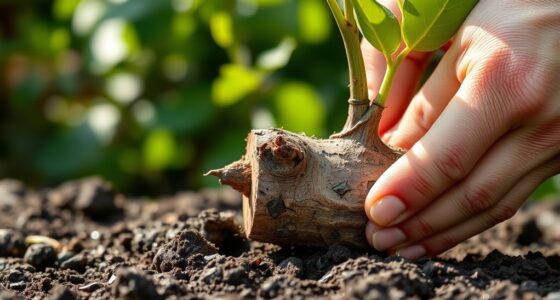Choosing between fall and spring planting impacts pest control and plant success. Fall planting offers fewer pests, letting your plants establish roots during cooler weather, which reduces the need for chemical controls. Spring planting might mean more pests emerge early, requiring proactive management. Cooler fall weather also helps plants develop resilience before pest populations rise. To make informed choices that maximize your garden’s health, explore the detailed differences and benefits of each season carefully.
Key Takeaways
- Fall planting reduces pest pressure due to lower pest activity compared to spring.
- Spring planting offers quicker harvests but requires more pest management efforts.
- Fall allows plants to establish roots gradually in cooler weather, increasing resilience.
- Spring planting risks early pest damage on young seedlings, demanding proactive controls.
- Timing fall planting to avoid pest life cycle peaks minimizes pest-related plant risks.

Pest management strategies differ markedly between fall and spring. In spring, pests tend to become active as temperatures warm up, so early planting can sometimes mean battling pests sooner. You might need to apply organic controls or barriers to protect your seedlings. Spring planting also requires vigilance against pests that overwinter in the soil, such as root maggots or certain beetles, which can attack young plants if not managed properly. Fall planting offers some advantages here: many pests are less active or have already completed their life cycle by fall, reducing immediate threats. Additionally, planting in fall allows plants to establish roots slowly during cooler weather, helping them develop resilience before pest populations ramp up in summer. Proper soil preparation and timing can also influence the timing of pest activity, which varies between seasons and affects how you plan your pest control strategies.
Frequently Asked Questions
Which Planting Season Yields Faster Crop Maturity?
Spring planting generally yields faster crop maturity because you can optimize planting density and adjust crop rotation to suit early-season growth. By planting early, you give your crops more time to develop, especially if you choose fast-growing varieties. Proper crop rotation helps prevent diseases, ensuring healthy growth. Focus on maximizing planting density without overcrowding, which promotes quicker maturity and better yields, giving you a faster harvest.
How Do Pest Populations Differ Between Fall and Spring?
You’ll notice pest populations differ between fall and spring due to pest migration patterns. In fall, pests often migrate into your garden seeking shelter, increasing pressure, while in spring, pests are just emerging from dormancy. Spring pests tend to be less resistant initially, but repeated exposure can lead to pest resistance. Managing these populations requires understanding migration trends and applying integrated pest control to prevent resistance buildup.
Are There Specific Crops Better Suited for Fall Planting?
You’ll be surprised to learn that some crops thrive in fall, especially those with frost tolerance. Cover crops like rye and clover are perfect because they protect soil and grow despite chilly temps. Ironically, planting these now keeps pests at bay and boosts soil health. So, if you want a head start or a resilient harvest, fall is your secret weapon for crops like spinach, lettuce, and winter herbs.
What Are the Soil Preparation Differences for Each Season?
When preparing soil for fall planting, you should focus on adding soil amendments like compost to boost nutrients, and use tillage techniques that help break up compacted soil. For spring, you might need to do more extensive tillage to aerate the soil after winter, and incorporate amendments early to make certain nutrients are available for fast-growing crops. Adjust your soil prep based on seasonal moisture levels and crop needs.
How Does Seasonal Planting Impact Long-Term Garden Health?
Seasonal planting affects your garden’s long-term health by influencing seasonal soil health and long-term sustainability. Fall planting helps build soil fertility through organic matter decomposition, promoting healthier plants over time. Spring planting, on the other hand, allows you to refresh your seasonal soil with new nutrients, ensuring sustained productivity. By choosing the right season, you support long-term sustainability and maintain resilient, thriving gardens year after year.
Conclusion
Choosing between fall and spring planting is like selecting the right season to plant a seed of hope. Each offers its own promise—the fall’s quiet patience or spring’s enthusiastic vitality. Whichever you pick, remember that your garden is a mirror of your dedication, growing stronger with each season’s change. Embrace the journey, for in nurturing your plants, you’re cultivating not just crops, but your own resilience and joy—seeds that will bloom in time.









